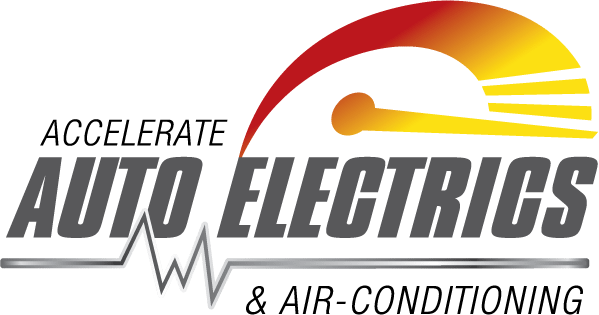Briohny: Hey guys. Briohny and Andrew here from Accelerate. We are standing in front of a 5th Wheeler that we have just done a lithium conversion on. So Andrew, tell us a little bit about the job, what’s happened?
Andrew: They live on cattle stations. They moved from cattle station to cattle station, a lot in the Gulf and Northern Territory and all of that. This thing is massive, I think it’s 30 foot, six tonne empty and a huge roof. Basically, because they’re full off grid, so wherever they go there is no power, nothing to plug into. So this one is all about the air-con. It actually runs two air conditioners, this system, and basically we’re giving them the leanest system we can at the moment with heaps of room for expansion. So as we go through it, we’ll show you where we’ve laid the foundations for a lot more expansion in this system. But this is as much to get them out of here, ready to go. And yeah, if they find it’s not quite enough, it’s gonna be very easy to add to it, wherever it might be.
Briohny: Cool, so let’s go take a look at it. Often with caravans, space and where we’re gonna put all this stuff is an issue, but not in the case of this 5th Wheeler, Andrew, where has everything gone?
Andrew: So this is the front boot. It actually worked out really well for us. All the solar was coming down the nose cone of this thing. So it actually all sort of terminated in this area. This is where some of the batteries were previously. It actually had two banks of batteries scattered throughout the place, but we’ve centralised it all here.
So basically what we’ve fitted in here is just pretty much our standard minimal system we do. We have done a few different things, so I’ll start with, there’s already 600 Watts of solar on the roof. And you’ll probably see in the video, it’s in some funny places, we were stuck with them that were glued and screwed and not coming off and they’re a bit of a different size. So we couldn’t reuse the mounts. So what we’ve done, we’ve actually run two completely separate solar banks on here. And we’re using the two different chargers. We’re running the initial solar, that was on the thing. We’re running that through the solar on the DC-DC at the moment you’ll see it’s making us 8 Amps, but the cloud has just gone over. We were getting nearly 20 out of it before when the sun came up and then our new bank which is ready for expansion is running through the Morningstar TriStar. So we’ve done that because the ones that are on the roof that were existing but were on a funny angle. So when the DC-DC kicks in, they’ll sort of… the DCDC will kick over when the alternator’s on and stop charging them. But we’ll still have plenty of solar on the roof ready to go, working. So he’ll still get the benefits of solar charging and alternator charging while he’s driving.
Briohny: So how much worth of extra panels did we put on the roof?
Andrew: So we put three, 180Ws.
Briohny: Yeah.
Andrew: but we’ve got room and cabling for number three down on the back ledge that you’ll see on the video, there’s a whole open space down the back.
Briohny: And so the new ones are going through the Tri-Star, old ones through the DC. Yeah.
Andrew: Correct, yeah, So we’ve got basically, we’ve got 2,600 watt inverter over there, the standard transfer Enerdrive inverter, we’ve got 400 Amps of lithium, but what we’ve done is we’ve left him room. He could still easily fit another one or two here. We’ve made it, so with the balancing, we’ve put the positive over the back corner. So he doesn’t need to touch that. This earth side will be able to move on to the next one. So he’ll be able to just get a parallel kit and add it on himself. So we’ve just really thought out the expansion in the future and the customer being able to do it themselves. So they’re the two batteries standard ePRO shunt, only a 40 Amp charger, which will be a bit under-gunned when we put the bigger… if we put the third battery in, but this thing’s never going to see power, pretty much we go to the power now to charge up the ePRO. And I don’t think it will see a power point again. That’s about it just to have DC-DC charger and our standard fuse box. So everything in the front here ready to go. We’ve added a couple extra power points ’cause he actually runs on the fridge in here while he’s travelling. And yeah, nice and plenty of room, easy to expand.
Briohny: So the inverter is changing the 12 volt power in the batteries to 240 volt power. So that’s allowing you to run your appliances,
Andrew: Correct.
Briohny: Yep. We’ve got the Tristar controller, which is doing the solar on the roof, the new panels.
Andrew: correct.
Briohny: The DC to DC charger is doing all the old panels, but when you’re driving, it will charge the batteries.
Andrew: Correct, with the alternator, it’s got a very big F truck with a large alternator, so it should be full 40 Amps on that.
Briohny: And then the AC charger is for charging when you plugged into power.
Andrew: Yup.
Briohny: Yeah, Cool. And then the ePRO, which is the shunt, you just see here, there’s a display for that inside somewhere.
Andrew: Yep.
Briohny: Thanks so much for watching guys as always, if you do have any questions you can drop the comment below. You can give us a call on 07 5479 6652 or email us at info@amae.net.au.

